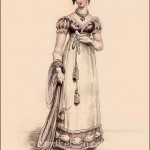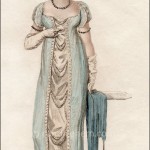Le Beau Monde, March 1808.
“Evening Full Dress.”
 The dress on the left looks simple enough, but the description suggests it would require a complicated effort to get on (even with the help of a lady’s maid). This dress also looks to have detachable long sleeves.
The dress on the left looks simple enough, but the description suggests it would require a complicated effort to get on (even with the help of a lady’s maid). This dress also looks to have detachable long sleeves.
The print is described in the magazine as follows:
“Fig. No. 1. — EVENING FULL DRESS.– A soft satin, of a beautiful amber and brown shot, worn over a sarsnet slip, made with a short train, a quarter and a half in length on the ground; the back of the dress is short and square; the sleeves are made in straight stripes down the arm, with a row of amber and white satin; they are quite plain, worn close to the arm, long sleeves confined round the wrists with pearl bracelets; a French body of white satin, fastened in the center of the bosom with a pearl broach, confined to the shape, and drawn down at each side of the neck, with pearl clasps to correspond. A broad band from the center of the bosom, confined round the waist, laced behind, and cut with a peak to fasten in the middle of the back. The front of the dress is made in one complete piece; the front is brought straight across the bosom, and the satin body is placed over it, which forms a satin tucker to the bosom. A rich drapery of white lace is thrown careless over the shoulders. The hair is dressed in a new style; ornamented with a pearl crown over the right eye, necklace and bracelets of correspond; French kid gloves, and white satin shoes.
“Fig. No. 2.– OPERA FULL DRESS.– A simple white muslin gown, made with a short train, and enriched round the bottom with a superb border of ruby foil, made perfectly plain, with a square back, and loose front, gathered into a band of white satin; the shoulder straps are also of white satin, which continue round the back; the sleeves are made short to cover only the top of the shoulder, gathered into a band of white satin, with scarcely any fullness to correspond. The dress is worn over white satin; a rich India ruby mantle, edged with gold, is suspended over the left shoulder, and conceals the arm. The hair is dressed plain, with a ruby handkerchief, tastefully placed across the head. Cornelian necklace and ear-rings. Shoes to correspond with the mantle and head-dress.”
The next section of the text discusses Gentleman’s Dress in general, but this part, following pronouncements that dark blue coats are the height of fashion, seems to describe the ensemble worn by the gentleman in the print:
“… but the approach of Lent will, in its usual course, introduce the wearing of black suits, as the most genteel and most proper Evening Dress, in all polite parties. The coat will, of course, be made double-breasted, and in the same stile of fashion as the coloured coats, with covered buttons; and, though black kerseymere waistcoats and breeches may be considered genteel, black silk Florentine will be more gentlemanly and fashionable.”







